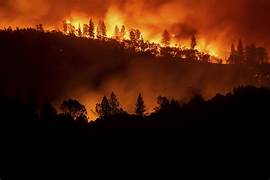On October 20, 2007, the United States faced one of the most devastating wildfire events in its history as a series of massive wildfires broke out across California. These fires, collectively known as the California Forest Fires, caused widespread destruction, loss of life, and significant environmental and economic consequences. The California Forest Fires of 2007 were fueled by a combination of factors, including a prolonged period of drought, strong winds, and dry vegetation. The fires spread rapidly across multiple regions of California, including Southern California, the Central Coast, and Northern California. The fires were responsible for the destruction of thousands of homes and buildings, displacing hundreds of thousands of people and causing the evacuation of numerous communities. Tragically, the fires also claimed the lives of several individuals, including firefighters who were battling the blazes. The magnitude of the California Forest Fires was overwhelming. The fires burned over 500,000 acres of land, equivalent to approximately 780 square miles. The flames destroyed more than 3,000 structures, including homes, businesses, and infrastructure. The economic toll of the fires was estimated to be in the billions of dollars. The firefighting efforts to combat the California Forest Fires were extensive and involved the collaboration of various agencies, including local, state, and federal authorities, as well as numerous firefighters and volunteers. Firefighters from across the country were deployed to California to assist in containing the fires and protecting affected communities. The California Forest Fires of 2007 highlighted the challenges and complexities of managing wildfires in a state prone to such events. The fires exposed the vulnerabilities of communities located in fire-prone areas and prompted a reevaluation of fire prevention and response strategies. In the aftermath of the fires, efforts were made to improve fire management practices and enhance the preparedness of communities. Fire prevention initiatives, such as controlled burns and vegetation management, were implemented to reduce the risk of future wildfires. Additionally, there were increased investments in firefighting equipment, technology, and resources to improve response capabilities. The environmental impact of the California Forest Fires was significant. The fires released vast amounts of smoke and pollutants into the air, leading to poor air quality and health concerns for those living in the affected areas. The fires also had ecological consequences, destroying habitats and causing the displacement of wildlife. The California Forest Fires of 2007 served as a stark reminder of the importance of fire safety and preparedness. They underscored the need for ongoing efforts to mitigate the risk of wildfires through land management practices, public education, and community engagement. Since 2007, California has experienced subsequent devastating wildfire seasons, further emphasizing the ongoing challenges faced by the state in managing and preventing wildfires. These events have prompted continued discussions and actions to address the complex issues surrounding fire management, climate change, and community resilience. The California Forest Fires of 2007 left a lasting impact on the affected communities and the state as a whole. The fires served as a wake-up call, highlighting the urgency of addressing the increasing threat of wildfires in a changing climate. They reinforced the importance of proactive measures to mitigate risks, protect lives and property, and preserve the natural beauty and resources of California.
20 Oct, 2007 U.S.A. California Forest Fires
